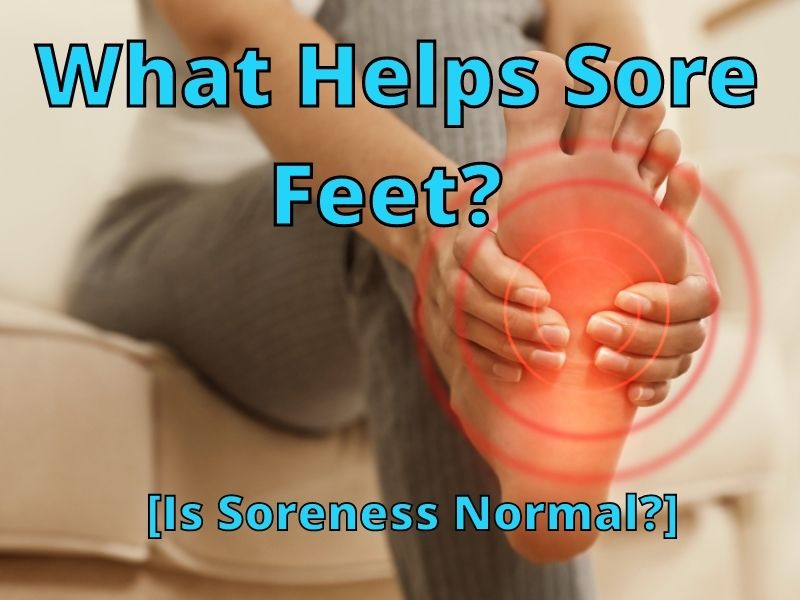(This article is not medical advice. Always consult your doctor for medical advice.)
It is common for most of us to experience sore feet from time to time after a long day at work. Fortunately, several home remedies can help you relieve your sore feet.
You can ease your tired and sore feet with warm foot baths, massages, arch supports, proper shoes, cold packs, medications, and foot creams. Soreness is normal for many but doesn’t have to be. Listed below are some ways to relieve foot soreness.
- Take a warm foot bath.
- Get a foot massage
- Use arch supports
- Apply an ice pack to your feet
- Take pain-relieving medications
- Apply pain-relieving foot creams
- Try night splints
- Elevate your feet
- Improve your posture
- Do some stretching exercises
- Wear proper shoes
- Switch your shoes regularly
- Consult your doctor
Foot soreness can be caused due to overworking, wearing the wrong footwear, and foot structure problems. We’ll also talk about ways you can avoid sore feet in the first place.
Sore feet can prevent you from enjoying a healthy lifestyle and may affect your daily activities. If you want to do something to ease your pain keep reading for ideas that help.
Common Causes of Sore Feet

Having sore feet after work is common, and most of us experience it regularly.
According to [Sore Feet – pdf], here are some of the major causes of sore feet:
- Flat feet
- Metatarsalgia: Commonly known as pain in the ball of your foot.
- Hallux valgus: Bunion
- Hallux rigidus: Stiff big toe
- Hammer toes: A deformity of toes.
- Arthritis of the foot: Tenderness or pain

| Causes | Reasons |
|---|---|
| Weight Gain or Obesity | Weight gain can cause stress and strain on your joints, ligaments, and muscles. |
| Pregnancy | As your hormones change during pregnancy, your ligaments become swollen and loose. |
| Over Working | Too much working, walking, or standing makes your feet tired and sore. |
| Foot Structure | Flat feet, wide feet, and high or low arches are more prone to foot soreness. |
| Foot Injury | Foot strains or sprains can make your feet tired and sore. |
| Ill-Fitted Shoes | Too tight, loose, wide, or narrow shoes cause foot soreness. |
What Helps Sore Feet?
Take A Warm Foot Bath

An easy and effective way to soothe your sore feet and alleviate foot pain is by taking a warm foot bath.
Soak your sore, tired and painful feet in warm water for about 15 to 20 minutes. You can also Epsom salt to the water. It will relieve sore feet, reduce foot swelling, and relieve muscle pain.
To make an Epsom foot bath take a tub or shallow bucket and fill it with warm water. Next, add a cup or half of Epsom salt to the water. Soak your feet in this mixture for as long as you feel relaxed. You can easily find Epsom salts in the foot care section of any drugstore.
An Epsom foot bath is an easy and inexpensive way to relax and soothe sore feet. Epsom salts offer several benefits to your feet:
- It relaxes and soothes your feet.
- It softens calluses and rough foot skin.
- It decreases foot swelling and inflammation.
- It relieves pain from several foot ailments.
Get A Foot Massage
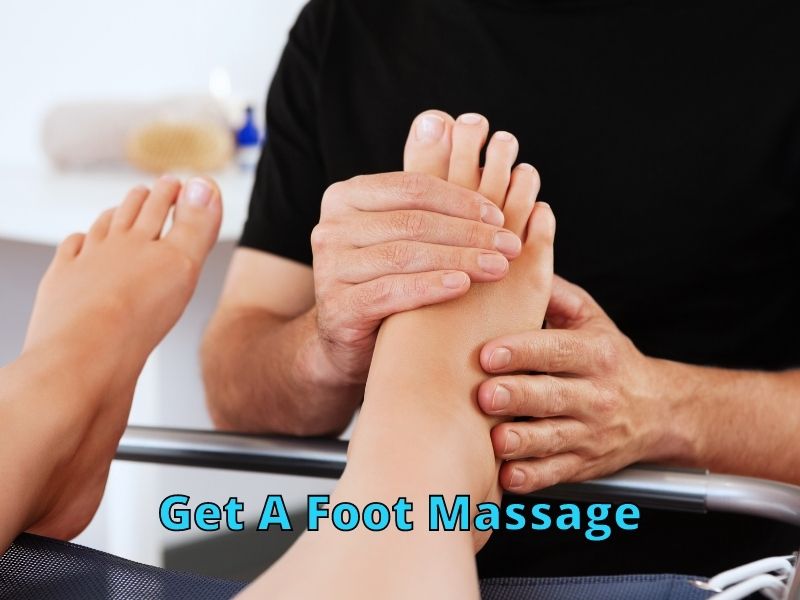
If you have someone to help, that’s even better, but you can do it yourself. Foot massage will reduce soreness and improve blood circulation.
Sit in a comfortable chair, relax your feet, rub the soles, and bend your toes to massage them. Gently stretch your foot muscles and toes.
You can apply oil, cream, or lotion to lubricate your foot skin. This will further relieve your sore feet and make massaging them easier. Massage your feet gently, pressing on the painful areas. If you have plantar fasciitis, then focus on your heels.
You can also use a foot roller or a foot massager to massage your feet or try other massage therapies.
- Sit in a chair.
- Take off your shoes.
- Put a tennis ball on the floor.
- Place your foot on the tennis ball.
- Press down and roll your foot from heel to toe over the tennis ball.
- Do it for about 10 minutes.
- It will gently massage your feet, relax the soreness, stretch tight foot muscles, and heal your feet.

Use Arch Supports
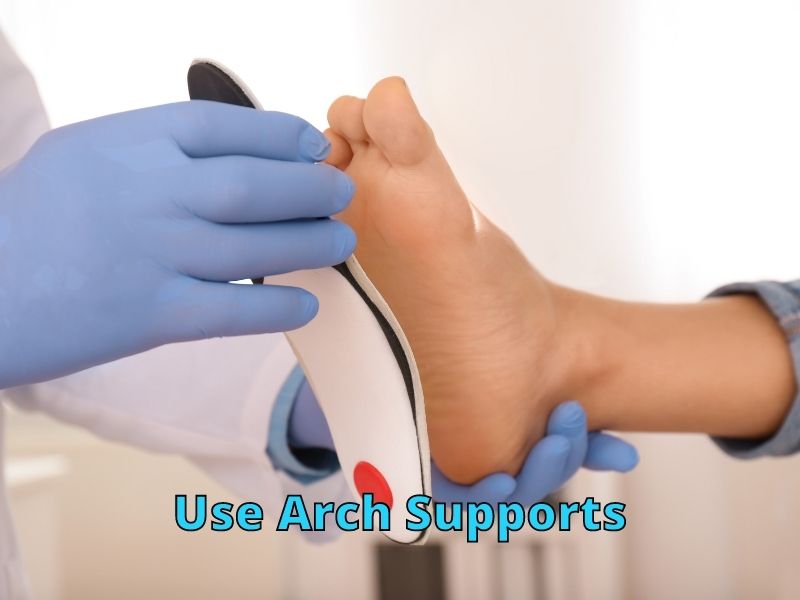
If you are constantly dealing with sore feet after work, you should try wearing arch supports or orthotics in your shoes. They will help reduce soreness and foot pain by keeping your feet stable while working, standing, or walking.
Arch supports for your shoes will provide some relief from your foot soreness. In addition, they reduce the shock that your feet experience with each step when you walk.
You can buy them from any local store or get them custom-made. Both will work in eliminating foot pain and reducing soreness. If you have soreness in the ball of your foot or heel, you should get full-length arch supports.
I would suggest getting custom-made arch supports with your doctor’s consultation to get a better fit. Suppose you have specific foot issues like flat feet or plantar fasciitis. In that case, you should consult a podiatrist to discuss custom-made orthotics or arch supports.
Apply Ice or Cold Pack to Your Feet

Each step you take or minute you stand, you are causing micro-damage to your feet that need to be healed. Using ice or a cold pack over your feet is an easy and effective way to heal this damage and relieve foot pain and soreness.
Icing your feet helps to reduce soreness and inflammation. There are several ways of icing your feet. For example, Take a plastic bag filled with ice cubes and rub it over the affected areas. Do not apply ice directly to your feet.
You can make an ice pack or a cold pack by wrapping a bag of ice in a cloth or towel. Hold the icepack on the affected areas or swollen feet for about 15 to 20 minutes. You should repeat it for about 20 minutes daily to reduce swelling and soreness.
Another way of icing your feet is:
- Fill a bottle with water, freeze it for 4 to 5 hours, and roll it over your feet.
- Sit down in a comfortable chair.
- Place the frozen bottle on the floor. Start rolling your feet over the bottle.
- Do it for 10 to 15 minutes several times daily to help reduce the soreness.
You can also try immersing your feet in cold water. Fill a bucket with water and ice. Dip your feet in the cold water for about 20 minutes. The cold water will combat the inflammation and swelling caused by working or standing for hours.
Foot pain caused by inflammation, infection, or arthritis can be relieved by icing your feet, but ensure you do not have any vascular problems.
Take Pain-Relieving Medications

Several pain-relieving medications are available to help with pain, soreness, and inflammation. You can use them to target your foot pain or foot soreness and inflammation.
Using these medicines for a few weeks will completely relieve your long-term foot pain and soreness. Furthermore, I would suggest consulting your doctor regarding medicine recommendations, the duration of their use, and how to avoid their side effects.
Apply Pain-Relieving Foot Creams

Besides medicines, you can also try applying pain-relieving medicated foot cream to help your foot soreness and pain.
These medicated foot creams offer pain-relieving and cooling sensations to relax your foot soreness. These foot creams may also contain turpentine, eucalyptus, and menthol to soothe inflammation and soreness.
Try Night Splints
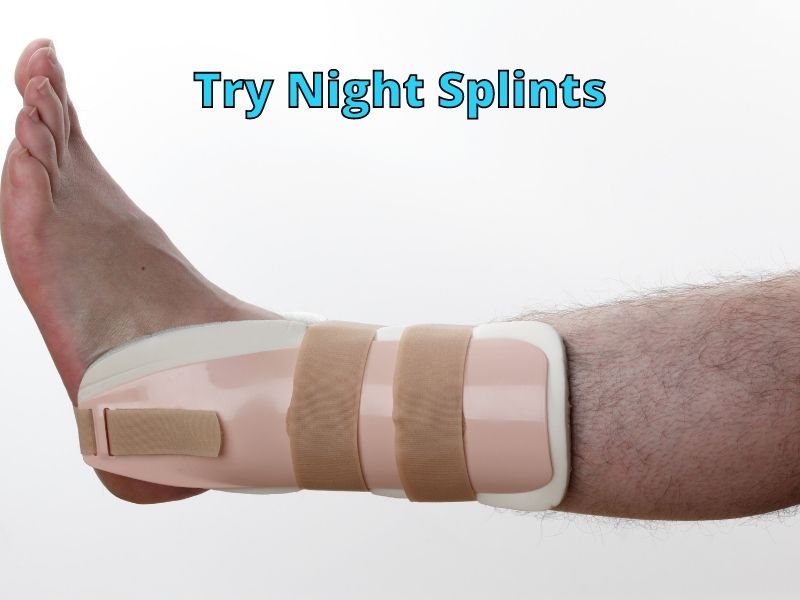
Plantar fasciitis can sometimes cause foot soreness and inflammation. So, you can try wearing night splints to address your foot pain and soreness while sleeping.
Night splints keep your feet fixed while you sleep to prevent them from pointing. In addition, it helps in reducing pain and soreness.
Plantar fasciitis is a common foot problem. It is estimated that up to 1 million people in the United States suffer from plantar fasciitis yearly. However, wearing night splints is an easy, effective, and inexpensive way to treat your plantar fasciitis. [Management of plantar fasciitis in the outpatient setting]
Elevate Your Feet
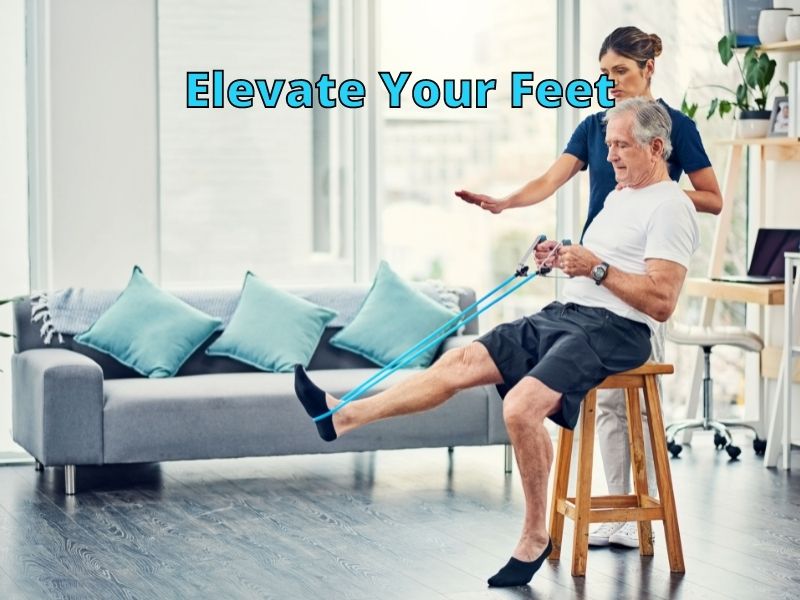
Having sore feet after a long working day can be frustrating. Lifting your feet above the rest of your body can help relieve foot soreness. For example, you can place your feet on a stack of pillows, a chair, or a footstool. It will ease your foot pain and soreness and will decrease the swelling.
Improve Your Posture
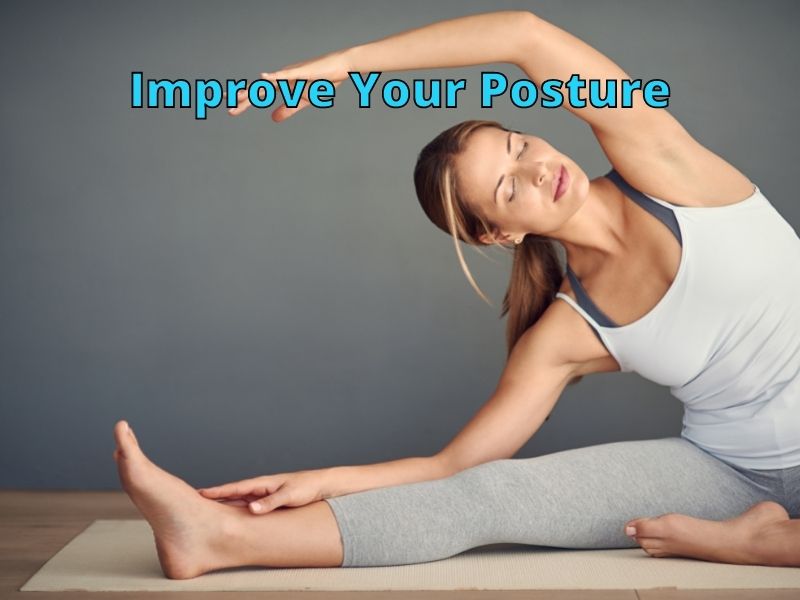
Poor foot posture can cause soreness, pain, injury, or inflammation in your feet, knees, and heels. In addition, an imbalance in muscle strength usually causes bad posture. As a result, your body is slightly tilted forward or backward, which may cause additional strain on your feet and heels.
Here are some tips to improve your posture:
- Use insoles in your shoes. They help in distributing pressure on your entire foot. Moreover, they keep your feet aligned and reduce ankle rotation.
- Your feet should be shoulder-width apart.
- Stand straight and keep your shoulder backward.
- Make sure to keep your weight on the balls of your feet.
- Relax your arms along the sides of your body.
Do Some Stretching Exercises

Working long hours can cause your foot muscles to become stressed and cause contraction spasms or soreness. You can relieve this tightness and soreness by stretching your feet regularly. [helpshoe] Taking a warm foot bath and stretching afterward will help relax your foot muscles.
You can target a specific area of your foot or your entire foot. These stretching exercises will help in relieving foot pain and increase foot flexibility. Stretching your feet will also relieve painful arches.
There are several ways to stretch your feet: [for details]
- Sit in a comfortable chair.
- First, warm up your feet by extending your legs.
- Next, move your toes toward your body and away from it.
- Then gently roll your toes in circles.
- Next, move your ankles in clockwise and anticlockwise directions.
- You can do it several times a day or try to stop every hour and stretch your feet.
Runners’ Stretch
- Stand against a wall. Place your hands on it.
- Extend one leg behind you.
- Push your heel down as far as possible.
- Hold this position until your foot feels stretched.
- Repeat it three times.
- Switch to the other leg.
Toe Curl
- Sit in a chair.
- Place a small towel on the floor.
- Place your one foot flat on the towel.
- Hold the towel between your toes and pull it towards your body.
- Repeat it five times.
- Switch to the other foot and perform the same.
Marble Pickups
- Sit in a chair.
- Place your feet on the floor.
- Put a few marbles and an empty bowl on the floor.
- Keep your heel on the floor. Put the marbles in the bowl using your toes.
- Make sure to pick one marble at a time.
- Do it with one foot a few times, and then switch to your other foot.
Wear Proper Shoe
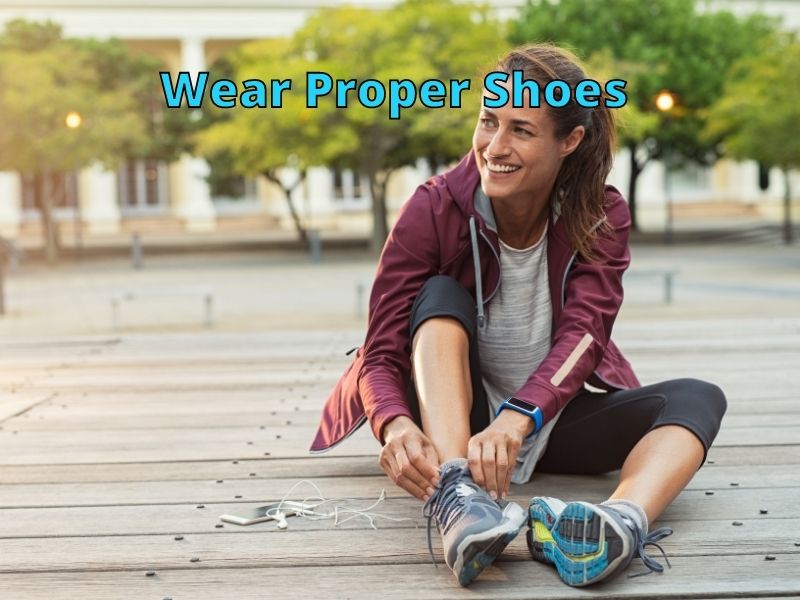
Foot pain, soreness, injuries, and inflammation can occur when you wear shoes that are too tight or loose, ill-fitted, or high heels or flat soles. Getting properly fitted shoes will help you deal with your foot soreness.
Wearing ill-fitted shoes will decrease blood flow to your feet and may cause blisters, foot pain, and soreness. In addition, it may cause walking, standing, and working uncomfortable.
If you are dealing with foot soreness and pain after a long work day, you may be tempted to try flat-soled shoes to help them. But that will not help you. Ideally, you need to wear shoes with heels higher than 1/4 inch and lower than 2 inches.
According to the study [WORKING ON YOUR FEET – pdf], it is recommended to elevate your heels by at least 1/4 inch and not more than 2 inches.
Here are a few things to consider in your working shoes: [for details]
- Your shoes should fit you well. They should neither be too tight nor too loose.
- Your shoes should be the right size and right shape. In addition, they should conform to your foot shape.
- Your heels should fit well without slipping.
- Your foot shouldn’t slide around in the shoe.
- Finally, your shoes should have a wide toe box.
- Also, your working shoes should provide enough arch and heel support to help reduce soreness in your feet and legs.
Here are a few tips while buying your shoes:
- I would recommend buying shoes with laces so that you can adjust them when your feet are swollen.
- Get your feet measured before buying shoes.
- It is also a good idea to buy shoes after a long day when your feet are swollen.
- Try shoes on your larger foot.
- You should go half a size larger when buying shoes.
Switch Your Shoes Regularly

Sometimes you experience foot pain and soreness even when wearing the right shoes that are properly fitted. This happens when you wear your shoes beyond their lifespan.
According to [Public Opinion Research on Foot Health and Care – pdf] High heels are the most common cause of foot pain and soreness among women! However, you can try switching to comfortable low-heeled shoes to reduce foot pain and soreness.
When To Switch Your Shoes:
- Replace your shoes every 6-8 months or after your shoes complete 500 miles.
- Switch your shoes when you feel your foot size has changed (due to age, weight gain, pregnancy, or other health conditions).
- Replace your shoe if they do not provide enough support or if you feel uncomfortable in the shoe.
- If you are feeling pain in high heels, switch to low-heeled shoes.
- Consider your activity and change your shoes accordingly.
- If you have plantar fasciitis, switch to wider shoes with cushioned soles.
Consult Your Doctor

Having sore feet after work is common, and most of us experience it regularly. However, if your foot soreness or pain worsens after trying home remedies, you should see a doctor.
These remedies or hacks may or may not work for you. If your foot soreness, pain, and inflammation persist for longer, you need to consult your doctor or podiatrist.
You should consult your doctor if you have:
- Diabetes or peripheral neuropathy
- Severe foot pain and soreness.
- Swollen feet for more than a few days.
- Continuous foot pain
- Cannot walk properly.
- Numbness, tingling, stinging sensation in your feet or toes.
- Lower limb swelling
- An open wound in your foot.
Thanks for visiting helpshoe.com
References
https://www.ncbi.nlm.nih.gov/pmc/articles/PMC4853481/
https://www.ohcow.on.ca/edit/files/general_handouts/WorkingonYourFeet.pdf
https://www.apma.org/files/APMA2014TodaysPodiatristSurveyAllFindings.pdf
https://europepmc.org/backend/ptpmcrender.fcgi?accid=PMC1870397&blobtype=pdf

